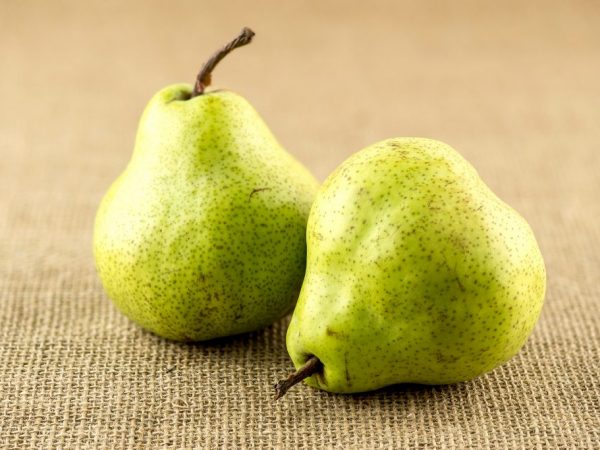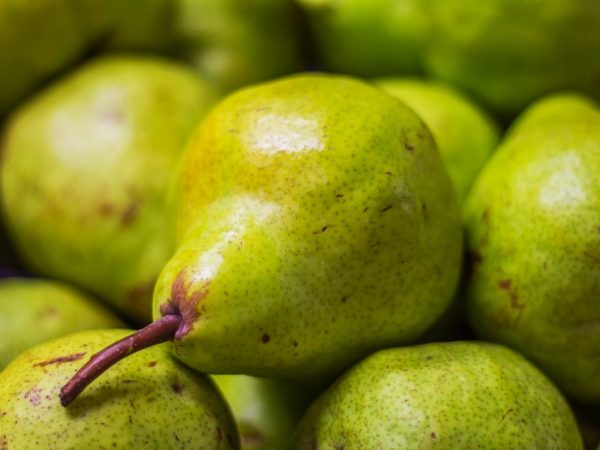Characteristics of Pakham pears
Pear Pakham is a storehouse of essential nutrients. Being hypoallergenic, it is approved for use by children from 6 months.

Characteristics of Pakham pears
Characteristics of the variety
It is a recently bred variety. Pear Barlett became the basis.
Ripening occurs in January and lasts until the beginning of autumn. The characteristic features of the variety are the presence of large, weighty fruits with tubercles and dots throughout the peel. The fruits of the Pakham pear have their own uniqueness - a light, fragrant aroma combined with a sweet-sour aftertaste.
Description of the tree
The seedling has a narrow pyramidal crown. The branches are strong. Leaves are medium in size. Over time, under the weight of the fruit, the branches tilt.
The dignity of the variety is regular fruitfulness. The first harvests appear around the 4th or 5th year. And for 20-30 years, the yield is stable. On average, 30-40 tons of pears can be harvested from 1 hectare of land.
The pear grows in almost any soil with the exception of sandy and gravelly. The best are clay soils.
Description of the fetus
By the ripening phase, the fruits acquire a greenish-yellow color. But by the time of consumption, the color becomes creamy.
The surface is slightly rough. The pulp is light and juicy in the context. It tastes sweet. Slightly crunches when biting through due to the presence of stony cells.

The fruits are greenish-yellow in color.
According to the description, the fruits have:
- low calorie content - only 48 kcal / 100 g;
- high percentage of carbohydrates - 10.9 g / 100 g of fetus;
- low acidity;
- a large amount of fiber, which improves the functioning of the gastrointestinal tract;
- pectin, which lowers cholesterol levels;
- high content of fructose, phosphorus, iron, folic acid, potassium, which improves the functioning of the pancreas, heart and other muscles.
The use of ripe fruits of this variety promotes the speedy elimination of heavy metals and toxic components from the body. A big plus is that these pears can be stored for up to 2 months, subject to temperature conditions.
Due to the fact that the pulp is not watery, the fruits are easy to transport. They are not very prone to damage.
Care
Due to its late ripening, Pakham does not tolerate temperature extremes, unlike summer pear varieties. After harvesting, the fruit must be carefully checked for defects.
Storage should be carried out in a dark, cool, well-ventilated area, with a temperature of 0-2 ° C. For this, cellars, rooms without heating, warehouses for vegetables or fruits are suitable. It is not recommended to store with products with a strong odor.
Winter varieties need high-quality insulation of the root system. For young trees, the following activities are additionally carried out:
- the trunks are wrapped with foil, cardboard, straw, or burdock, sunflower leaves;
- do not allow weeds to overgrow the near-stem circles;
- careful and regular watering is necessary;
- autumn feeding is carried out with potassium and phosphorus fertilizers;
- whitewashing of trunks is needed;
- mulch with peat or sawdust with a layer of up to 25 cm.
Before the onset of cold weather, plants should be treated with Ekoberin or Zircon solutions. This increases resistance to adverse weather conditions.
Protection
The seedlings require additional frost protection. To do this, they are wrapped in burlap. Old trees are also protected from possible rodents, enveloping the bottom of the trunk with a dense canvas cloth and impregnated with pest repellents. Mulching is carried out using humus, sawdust, pine branches, crushed bark.
Fertilizer
Top dressing is carried out throughout the year, except for winter. Main steps:
- With the arrival of spring, liquid or solid fertilizers are applied at the root. By summer, feed with preparations containing nitrogen. Since June, it has been customary to introduce nitrogen-containing preparations by spraying.
- In July, mineral and nitrogen supplements are used. The addition of phosphorus and potassium is possible.
- In September, the last term for feeding with nitrogen substances. It is needed to stimulate growth. Before the beginning of winter, it is recommended to feed with potassium and superphosphate in the trunk circle.
Winter varieties require increased protection on cold days. If the planting was carried out in the summer, then watering should be done regularly. Because Since such trees are not yet sufficiently rooted, their near-stem areas require frequent loosening, weeding and fertilization.

Pear varieties Pakham need quality care
Watering
After planting in the ground, the seedlings must be provided with moisture. After irrigation, the soil is gently loosened to avoid crusting. So that the water does not evaporate quickly, the place of irrigation is sprinkled with manure and dry foliage, grass.
Pruning
Mature trees require pruning old branches to start new, young ones. This process is aimed at the correct formation of the trunk. Often, due to bountiful harvests, branches break. Therefore, the formation of unnecessary forks is prevented.
Pests and diseases
The pear is susceptible to attacks by insect pests or diseases. The most common diseases are:
- Scab. Where the fungus has started, infection occurs from the leaves. Light green spots appear. Further, traces of rot pass to the fruit itself, on which cracks soon appear. In the process, the pulp ossifies. All spoiled fruit should be collected immediately to avoid contamination of healthy fruit. Prevention will be spraying trees with 1% Bordeaux mixture.
- Moniliosis or fruit rot. Throughout the fruit, spreading spores of fungi, beige convex spots and growths grow. Easily spread through the air with insects or wind between all trees on the site. Such fruits quickly crumble. Timely pruning of trees, frequent collection and elimination of infected fruits will serve as prevention.
- Black cancer. Appears on the bark of branches and trunk. First, in the form of small cracks, growing and increasing in size, tearing at the end of the bark of the tree. The edges of the wound are dark brown in color, into which germs can easily enter, as well as fungal spores that provoke diseases. The affected area is cut with a sterile instrument, touching the healthy part. Then the wound is moistened with a solution of copper sulfate and covered with clay with a mullein.
To eliminate pests, insecticides, fungicides are used. Smoking is also carried out with the help of tobacco, pungent odors.
To combat scab, use a solution from copper sulfate and Bordeaux liquid. Only the infected areas of the plant are sprayed. If the solution gets on healthy leaves, it can burn them.
You can get rid of moniliosis with the help of special chemicals. The best among them are "Horus", "Strobi", "Bordeaux mixture", "Abiga-Peak". Biological means of protection - "Alirin-B", "Gamair" and "Planriz" are also suitable.
Conclusion
Pakham pears are valued for their high yields - up to 40 tons per hectare of land.Its other advantage is juicy, tasty fruits that can be consumed even by young children. Their benefit lies in the presence of vitamins A, B1, B2, E, P, PP, C and fiber.


